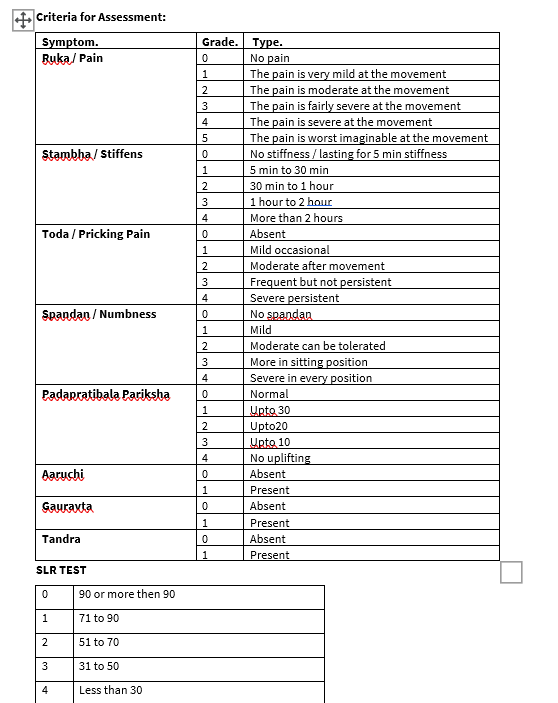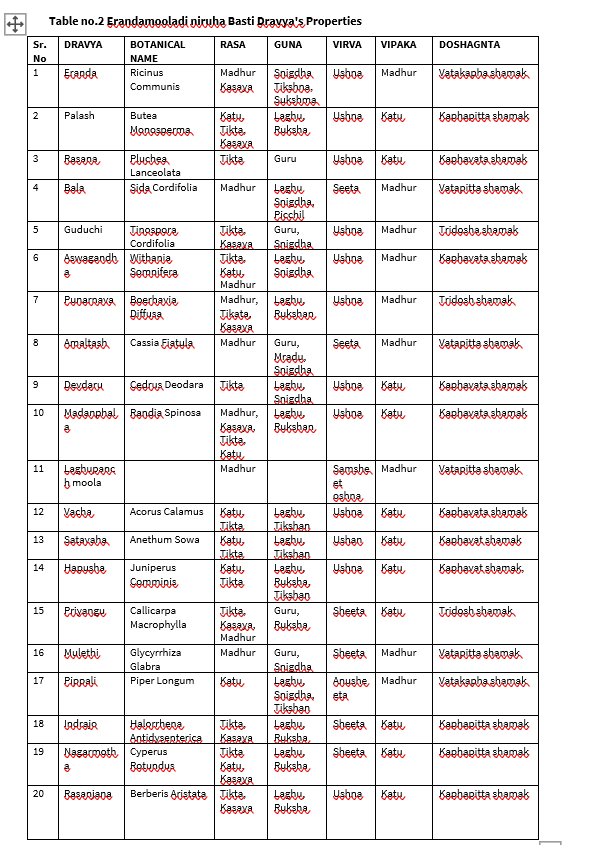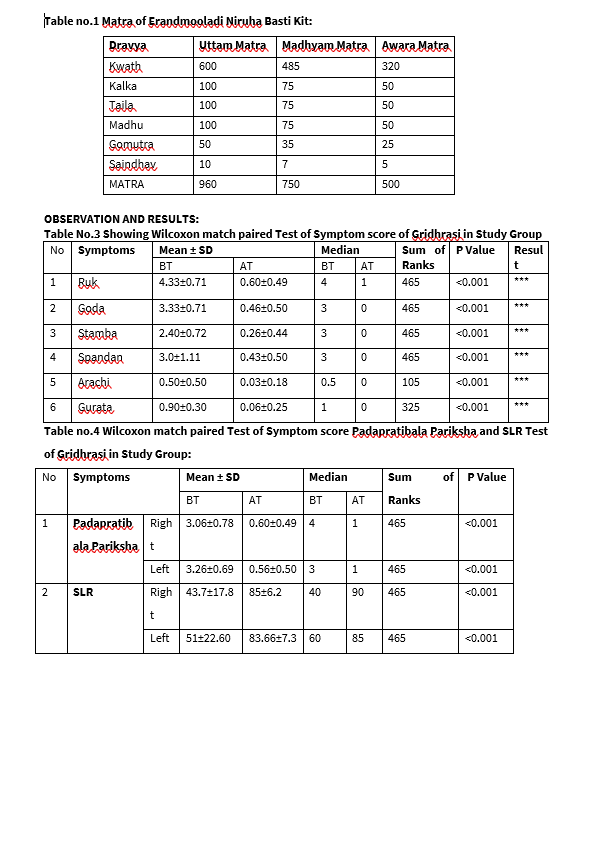Original Article
Year: 2022 |Volume: 3 | Issue: 01 |Pages: 29-30
A open label clinical study to determine the effectiveness of Erandamooladi Niruha Basti Kit in Gridhrasi ( Lumbar spondylosis with radiculopathy)
About Author
Correspondence Address:
Dr Vedprakash Gahukar Consultant & Ayurveda Head, MedAyu Hospital, Shankarpur, Nagpur Email : medayuhealthcare@gmail.com
Date of Acceptance: 2022-01-19
Date of Publication:2022-02-10
Article-ID:IJIM_135_02_22 http://ijim.co.in
Source of Support: nil
Conflict of Interest: nil
How To Cite This Article: Gahukar V, et al. A open label clinical study to determine the effectiveness of Erandamooladi Niruha Basti Kit in Gridhrasi ( Lumbar spondylosis with radiculopathy). Int J Ind Med 2022;3(1):29-39
Abstract
Gridhrasi (Sciatica) is one of the most common Vatavyadhi. Ayurveda categorized Gridhrasi as one of diseases caused by vitiation of Vata. Sometimes even Kapha vitiation along with Vata (vata kaphaj) also causes Gridhrasi. Objective: To determine the effectiveness of Erandmooladi Niruha Basti in the management of Gridhrasi (Lumbar spondylosis with radiculopathy). To establish evidence-based medicine to treat the Gridhrasi effectively with the intervention of Erandmooladi Niruha Basti. Methods: The study was open label, clinical study. The patients of either sex between age group 18 - 60 years have been selected from the OPD and IPD of MedAyu Hospital, Shankarpur, Nagpur. The Erandmooladi niruha basti (prepared standard kit) is given to the patient on regular basis for 15 days and if rukshana occurs matra basti of murchita tila taila was given to the patients. The duration of treatment was 15 days along with the regular exercise and pathya (diet). Conclusion: intervention of prepared Erandamooladi basti kit effectively relieved the signd and symptoms of Gridhrasi (Sciatica) and its associated complaints
Keywords: Erandmooladi niruha basti, Gridhrasi , Pathya, Vatavyadhi
Introduction
Gridhrasi (Sciatica) is one of the most common Vatavyadhi and according to Acharya Charaka major clinical symptoms of Gridhrasi are pain, stiffness, and twitching over lower back (Kati/Prishta), thighs (Sphik/Jangha), knees (Janu) and legs (Pada).1 In Gridhrasi, Tandra (Drowsiness), Gaurav (Heaviness), and Aruchi (Anorexia) may be present if Kapha is associated with Vata.2,3 There are eighty types of Vatavyadhi, the Gridhrasi is one of it4 and Gridhrasi is a Vataja- dosha related disorder, particularly Apana Vata, is causing difficulties in Sphikpradesh as a result of indulgence of various Vatakaraka nidana, followed by Kati, Prishta, Uru, Janu, Jangha, and Pada.5
Factors such as poor workplace sitting postures and jerky motions are responsible for the Low back pain and sciatica.6 Low back pain is the one of the leading reasons for all physician visits by the patients.7 The prevalence of sciatica varies considerably ranging from 3.8% in the working population to 7.9% in nonworking population.8,9
This study is conducted to evaluate the effectiveness of Erandmooladi Niruha Basti Kit10 in the management of Gridhrasi. The details of Erandmooladi Niruha Basti has been explained in Charak Samhita and Ashtanghrudaya. This basti is useful in treating mandagni, shula in jangha, uru, koshtha, kati, pada, trikapradesh, hriday, gudashoola, guruta, vibandha, gulma, grahini roga etc. This basti is basically lekhana basti as all the drugs mentioned in this basti having ushna and tikshna properties.
Objective:
-
To determine the effectiveness of Erandmooladi Niruha Basti Kit in the management of Grudhrasi (Lumbar spondylosis with radiculopathy)
-
To establish evidence-based medicine to treat the Grudhrasi effectively with the intervention of Erandmooladi Niruha Basti kit.
Material and methods:
Study Design -
The study was open label, clinical study. The patients of either sex between age group 18 - 60 years have been selected from the OPD and IPD of MedAyu hospital, Shankarpur, Nagpur. The patients were diagnosed based on classical signs and symptoms of disease as per Ayurvedic classics and investigation of the patients like Straight Leg Raise (SLR) test along with neurological examinations were done. Before administration of the therapy, a detailed proforma CRF, where in complete history, signs and symptoms, Dashvidha pariksha, Ashtavidha pariksha, nidana panchak etc were compiled together, for each patient. A well-Informed consent also obtained from each patient.
Sample size – Total 30 patients
Intervention - For this study, Total 30 patients were selected according to inclusion criteria. The special Kit was prepared of Erandmooladi niruha basti using ingredients in it, sarwang snehana and swedana was performed for each patient then basti is given to the patient for 15 days. If any symptom like rukshana occurs matra basti of murchita tila taila was given to the patients. The duration of treatment was 15 days along with the regular exercise and pathya (diet) .

criteria

table2

table3
Drugs content of Basti kit -
Kwath dravya: Erandmoola, palash twak each 3-3 pal, laghupanchmoola, rasna, balamoola, guduchi, aswagandha, punarnava, amaltash, devdaru, each 1-1 pal, madanphala-8. Crush them in small pieces and boil in 2 aadhaka jala till it remain ashtamanssh
Kalkadravya: Balvacha, soya, hribair, priyangu,mulethi, pippali, indrajo, nagarmotha, rasanjana each 1-1 karsh . take fine powder of the drugs and mix them with water
• Taila- Murchita tila taila
• Madhu
• Gomutra
• Saindhava
Preparation :
First, madhu is to be taken in the mortar, and then saindhava is to be added., continuous churning is to be done to make a homogenous mixture. After that taila of required amount is to be added slowly and stirring is to be continued until a uniform consistency is attained kalka is to be added then. After that required amount of kwath is to be added slowly and part by part for proper mixing. Last of all avapa is to be mixed. The mixture is to be filtered through a fine sieve. Finally, it is made lukewarm by keeping over a vessel containing hot water.
Effect of Therapy on Symptoms of Gridhrasi in Study Group Statistically:
For the analysis of subjective criteria in Study Group , the Wilcoxon Signed Rank Test was applied for Symptom score of Gridhrasi , results obtained are as follows.
In symptom Ruka, the Mean ± SD value obtained Before Treatment (BT) was 4.33±0.71 and After Treatment (AT) it was obtained as 0.60±0.49 which was statistically highly significant (p<0.001).Similarly in the symptoms Goda, Stamba, Spandan, Arachi and Gurata there is significant difference in the score of before treatment and after treatment. The P value obtained was less than 0.05 which was statistically highly significant (p<0.001). It means that there is a significant difference with the intervention for these symptoms.In the criteria, Padapratibala Pariksha and SLR test P value is less than 0.05.,which was statistically highly significant (p<0.001). It means that there is a significant difference with the intervention for these criteria.
Discussion
Gridhrasi is one of 80 Nanatmaja Vatavyadhis i.e. it is caused only because of vitiated Vata. Hence, Vataprakopaka Lakshanas like Shoola, Supti, Stambha etc. are found as the cardinal symptoms in the disease. Ativyavaya causes Apanavata prakopa which is the main culprit in Gridhrasi, while Vegavarodha, Ratrijagran and Divaswapan are other factors.11 After completion of Panchakarma procedures with the Basti with using of kit Murchit Til Taila 50ml, Erandamuladi Bharad 50g. Vachadi Churna 30g, Madhu 50ml, Saindhav 5gm, patient condition was assessed for pain, giddiness, neck stiffness, neck motion, power and reflexes of upper and lower limbs.12 The common line of treatment of Vatadosha is also applicable here. Vagbhat has stated that Sneha, Sweda, Mruda Samshodhana along with Madhur, Amla, Lavana dravyas.13 Basti stays at Pakwashaya, but due to its virya, acts on the doshas from top to toe and scabs off the doshas from kati, and removes them through anus. Snehabasti strengthens pada, jangha, uru, kati, prishtha.14 Nidana Parivarjana (avoidance of causative factors), is the first and foremost principle to be adopted in the treatment. As intensity of the Dosha Prakopa should be considered before deciding the line of treatment. If, Doshas are in Prakopa avastha, Shodhana treatment should be decided.16 It was observed that the intervention with Erandamooladi basti was very significant particularly for the symptom Ruka, Goda, Stamba, Spandan, Arachi and Gurata there is significant difference in the score of before treatment and after treatment. It means that there is a significant difference with the intervention for these symptoms.
MODE OF ACTION OF BASTI:
1)Saindhava (Salt) - Saindhava lavana is considered best of all the lavana described in Ayurveda because of its-
Sukshma Guna - It reaches up to the microchannels of the body
Tikshna Guna - It breaks down the morbid mala and dosha sanghata. By liquefies the dosha, saindhava play an important role to initiate the absorption of Basti.
2) Madhu (Honey) - Main role of madhu is to increase the retention time of Basti by counteract the irritative property of saindhava. The retention time of irritative substance in rectum may be favored by making solution as nearly isotonic as possible by using colloidal fluid.
3) Sneha (Oil) - Sneha dravya soften body microchannels (Srotas), destroy the compact mala and removes the obstruction in the channels. By using sneha the fat soluble portion of the drug easly absorbed from the colon. Lipids and lipid soluble substance can easily enter the cell because of cell wall is made of lipids so by the sneha properties basti dravya can reach at cellular level and also protects the mucous membrane from the untoward effect of irritating drugs in the Basti dravya.
4)Kalka (Powder) - It gives required thikness to the Basti, fresh drug and drug containing volatile property (to enhance potency) can be utilized in the form of kalka.
5) Kwatha (Decoction) - It is use to get water soluble part of kwatha dravya. In stead of kwatha, ksheera, gomutra, amlakanji, mamsarasa etc. are also used or for the preparation of kwatha it self.Kalka & kwatha serve the function of utkleshana or doshaharana or shaman depending upon their contents and selected accordingly.
6) Avapa Dravya - They are used some time in order to make the Basti either tikshana or mridu and to affect the particular dosha. Avapa dravya is also used for elimination of particular Dosha.
Absorption of Basti - First sodium ion in saindhava actively absorb from colon. High concentration of sodium ion facilitates sugar influx. Increase sodium ion in mucosal membrane generate osmotic gradient.
Water follows these osmotic gradients thus passive absorption of water take place. Free fatty acid is easily absorbed by passive diffusion in the colon. The absorption of drug through the rectum is taken away in the superior, middle or inferior hemorrhoidal veins and then into portal vein, inferior vena cava and systemic circulation. When these drugs are absorbed through villi of large intestine, it is carried away in right, left of middle colic vein to the portal circulation and to inferior vena cava,The drug giving through anal route, resulting avoid of drug's metabolism which occurs in stomach or upper gastrointestinal tract. This is the way to enhance drug's effect.
Conclusion
Ghridhasi is a painful condition and is treatable in with Ayurveda system. The Shaman treatment of Gridhrasi in is not much effective independent as it also required Shodhan therapy. Gridhrasi which showed a good result principally. Further, clinical studies are required for complete evaluation. The Shamana medicines given after Shodhana therapies would be effectively for prevention and to overcome the problem of recurrence of the disease. Intervention of Erandamooladi basti kit is effectively relieved signs and symptoms of Gridhrasi (Sciatica) and its associated complaints. It can be recommend for the treatment management of Gridharsi in order to improve quality of life of patients and to overcome the morbidity.
References
- Sharma PV, editor. Chikitsasthana; Vatavyadhichikitsa Adhyaya. Charaka Samhita of Agnivesha. 8th ed. Chapter 28, Verse 56. Varanasi, India: Chaukhamba Orientalia; 2007. p. 466.
- Sushruta, Sushruta Samhita. Sharma PV, editor. Nidanasthana; Vatavyadhi Nidana Adhyaya. Chapter 1, Verse 74. Varanasi, India: Chaukhambha Visvabharati; 2005. p. 15.
- Charaka Samhita of Agnivesha.Sharma PV, editor. Chikitsasthana; Vatavyadhichikitsa Adhyaya 8th ed. Chapter 28, Verse 57. Varanasi, India: Chaukhamba Orientalia; 2007. p. 466.
- Charaka Samhita Sutrasthana20th chapter 11th shloka -Vidyotini Hindi commentary by Kashinath Shastri and Gorakhnath Chaturvedi, edited by Rajeshwardutt Shastri, Pandit Yadunandan Upadhyaya, Pandit Gangasahaya Pandeya, Dr. Banarasidas Gupta; Reprint year 2011, Chaukhambha Bharati Academy, Varanasi, India, Page no 399.
- Charaka Samhita Chikitsasthana 28th chapter verse 56, - Vidyotini Hindi commentary by Kashinath Shastri and Gorakhnath Chaturvedi, edited by Rajeshwardutt Shastri, Pandit Yadunandan Upadhyaya, Pandit Gangasahaya Pandeya, Dr. Banarasidas Gupta Reprint year 2011, Chaukhambha Bharati Academy, Varanasi, India, Page no 787
- Andersson, G.B.J. The epidemiology of spinal disorders. In The Adult Spine: Principles and Practice, 2nd ed.; Frymoyer, J.W., Ed.; Lippincott-Raven Publishers: Philadelphia, PA, USA,1997; pp. 93–141.
- Harrison’s principles of internal medicine. Anthony S.Fauci editors. Mc Graw hill Publication. 18th ed. Vol 1, 2013.Page No.341.
- Kaila-Kangas L, Leino-Arjas P, Karppinen J, Viikari-Juntura E, Nykyri E, Heliövaara M. History of physical work exposures and clinically diagnosed sciatica among working and nonworking Finns aged 30 to 64. Spine (Phila Pa 1976) 2009;34:964-9.
- Mohan M, Sawarkar P. Ayurvedic management of Gridhrasi with special respect to sciatica: a case report. J Indian Sys Medicine 2019;7:131-8.
- Charaka Samhita of Agnivesha.Sharma PV, editor. Sidhhisthana; Adhyaya 8th Chapter 3, Verse 38-42. Varanasi, India: Chaukhamba Orientalia; 2007. p. 586
- Patil NJ, Patil D, Padmini Tekur, Venkatarathnamma PN, Manohar PV. Sciatica (Gridhrasi) - An Ayurveda Perspective. J Ayurveda Integr Med Sci 2017;5:102-112.
- Astanga Hridaya Sutasthana13th Chapter 1st -3rd Shloka-Nirmala hindi commentary by Dr. Brahmanand Tripathi; Reprint 2013, Chaukhambha Sanskrit Pratishthan, Delhi, India, Page no. 185.
- Sushruta Samhita Chikitsasthana 35th chapter 28th -29th shloka, edited with Ayurveda Tattva Sandipika Hindi commentary by Kaviraja Ambikadutta Shastri and forwarded by Dr. Pranajivana Manekchanda Mehta, ReprintYear 2007, Chaukhambha Sanskrit Sansthan, Varanasi, India, Page no 151.
- Charaka Samhita Siddhisthana 04th Chapter 24th shloka - Vidyotini Hindi commentary by Kashinath Shastri and Gorakhnath Chaturvedi, edited by Rajeshwardutt Shastri, Pandit Yadunandan Upadhyaya, Pandit Gangasahaya Pandeya, Dr. Banarasidas Gupta; Reprint year 2011, Chaukhambha Bharati Academy, Varanasi,India, Page no 1008
- Charaka Chikitsa Sthana 28/75 Charaka Samhita, Ayurveda Deepika, Yadavji Trikamji, Reprint Edition 2009, Varanasi, Chaukhamba Orientalia p 620
Conflict of interest :
Dr Vedprakash Gahukar is a Consultant & Ayurveda Head, MedAyu Hospital, Shankarpur, Nagpur
Dr Dhanraj Gahukar working as Director MedAyu Hospital Shankarpur Nagpur.
Dr. Priti Gahukar is Academic Head, Gahukar Education and Research Foundation
Source of support: This trial expenses done on behalf of MedAyu Hospital, Shankarpur, Nagpur.
"

